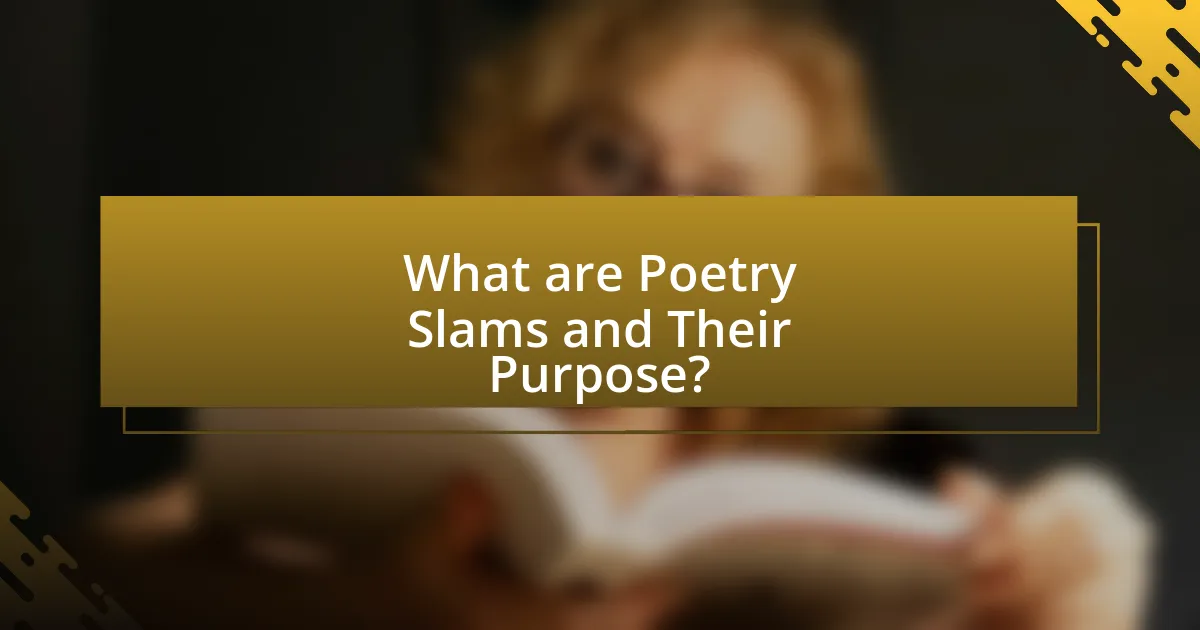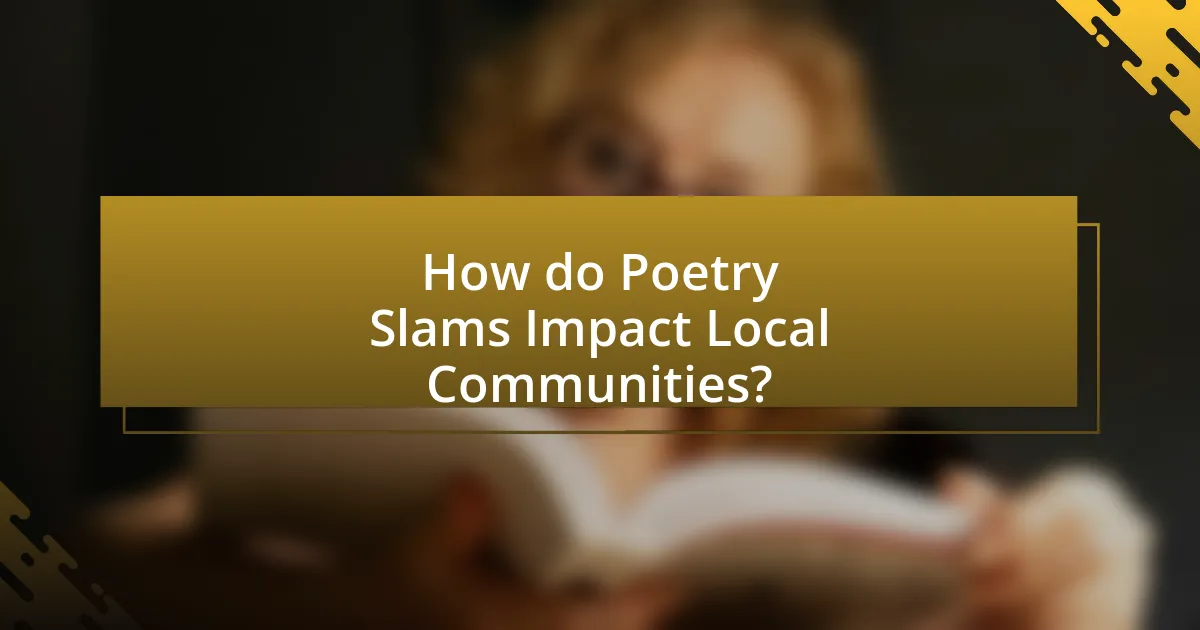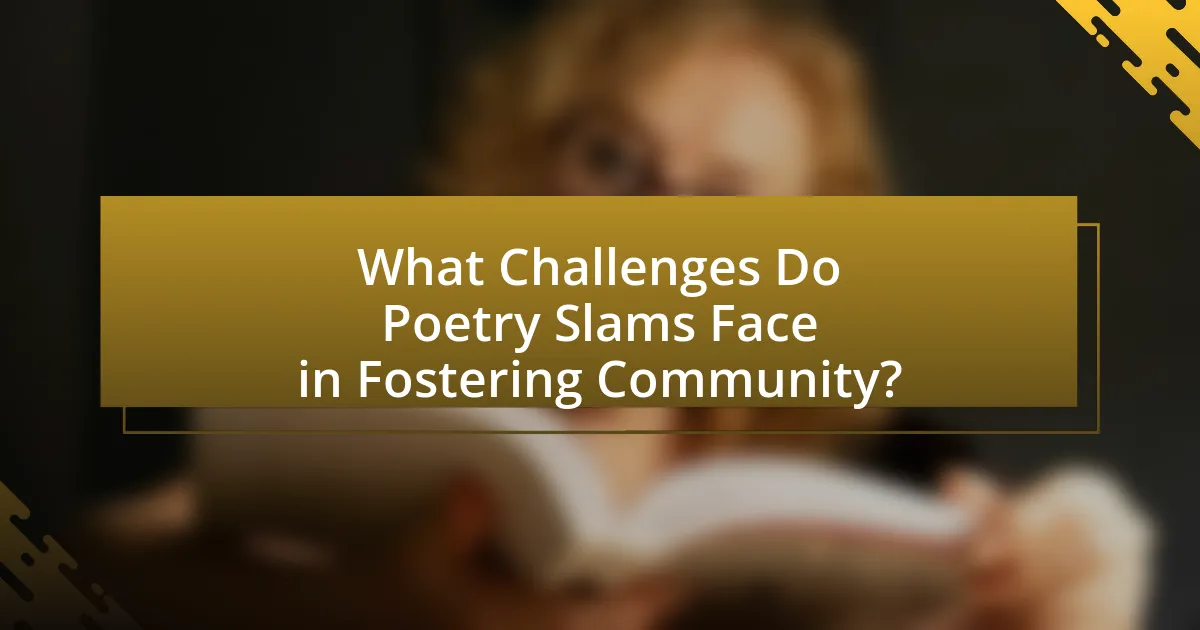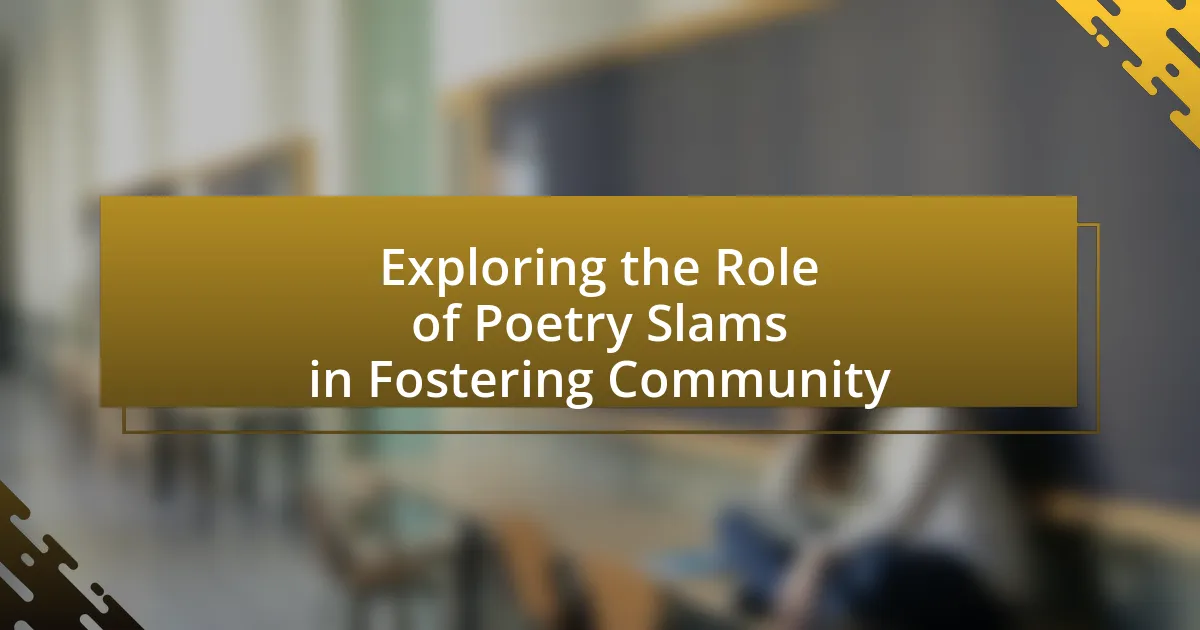Poetry slams are competitive events that provide a platform for poets to perform original works, fostering community engagement and self-expression. This article explores the role of poetry slams in promoting diverse voices, enhancing social cohesion, and addressing social issues through the art of spoken word. Key elements of poetry slams, such as performance, audience participation, and competition, are examined, along with their impact on mental health, cultural exchange, and community building. Additionally, the article discusses challenges faced by poetry slams, including inclusivity and accessibility, and offers strategies for enhancing engagement and collaboration within local communities.

What are Poetry Slams and Their Purpose?
Poetry slams are competitive events where poets perform original works before an audience and are judged by selected members of that audience. The primary purpose of poetry slams is to provide a platform for diverse voices and foster community engagement through the art of spoken word. These events encourage self-expression, promote cultural exchange, and often address social issues, making poetry accessible and relevant to contemporary audiences. The format of poetry slams, which typically includes time limits and audience participation, enhances the dynamic nature of the performances, creating an inclusive environment that celebrates creativity and dialogue.
How do Poetry Slams differ from traditional poetry readings?
Poetry slams differ from traditional poetry readings primarily in their competitive format and audience engagement. In poetry slams, poets perform their work in front of an audience that actively participates by scoring the performances, creating a dynamic and interactive atmosphere. This contrasts with traditional poetry readings, where poets typically read their work in a more formal setting without audience scoring or direct interaction. The competitive nature of slams encourages poets to deliver emotionally charged and impactful performances, often leading to a stronger sense of community among participants and spectators.
What elements define a Poetry Slam event?
A Poetry Slam event is defined by several key elements: performance, competition, audience participation, and time constraints. Performance involves poets delivering original works, often with emotional intensity and creativity. Competition is structured, typically featuring multiple rounds where poets are judged based on criteria such as content, delivery, and audience engagement. Audience participation is crucial, as the crowd often influences the atmosphere and scoring, creating a dynamic interaction between performers and spectators. Time constraints are strictly enforced, usually limiting each poet to a specific duration, often three minutes, to ensure a fast-paced and engaging event. These elements collectively contribute to the unique and vibrant nature of Poetry Slams, fostering community through shared experiences and artistic expression.
Why is performance an essential aspect of Poetry Slams?
Performance is an essential aspect of Poetry Slams because it transforms poetry into a dynamic and engaging experience that fosters audience connection and emotional resonance. The act of performing allows poets to convey their messages through vocal delivery, body language, and emotional expression, which enhances the impact of their words. Research indicates that live performance can significantly increase audience engagement and retention of the material presented, as demonstrated in studies on the effects of performance on communication effectiveness. This interactive nature of Poetry Slams not only captivates the audience but also creates a sense of community, as participants share personal stories and experiences, fostering empathy and understanding among diverse groups.
What role do Poetry Slams play in community building?
Poetry slams play a significant role in community building by providing a platform for diverse voices to express their experiences and connect with others. These events foster inclusivity and encourage participation from various demographic groups, creating a sense of belonging. Research indicates that poetry slams can enhance social cohesion, as they often address shared community issues and promote dialogue among participants. For example, a study published in the Journal of Community Engagement and Scholarship highlights how poetry slams facilitate cultural exchange and understanding, ultimately strengthening community ties.
How do Poetry Slams foster connections among participants?
Poetry slams foster connections among participants by creating an inclusive environment that encourages self-expression and shared experiences. This format allows poets to perform their work in front of an audience, facilitating immediate feedback and emotional resonance. The communal atmosphere of slams promotes interaction, as participants often engage in discussions about the themes presented, leading to deeper understanding and empathy among them. Research indicates that such events can enhance social bonds, as they provide a platform for individuals to connect over shared narratives and cultural backgrounds, ultimately strengthening community ties.
In what ways do Poetry Slams encourage diverse voices?
Poetry slams encourage diverse voices by providing a platform for underrepresented individuals to express their unique perspectives and experiences. These events often prioritize inclusivity, allowing participants from various backgrounds, including marginalized communities, to share their stories in a supportive environment. Research indicates that poetry slams foster community engagement and cultural exchange, as they attract diverse audiences and participants, thereby amplifying voices that may be overlooked in traditional literary spaces. Additionally, the competitive yet collaborative nature of slams encourages performers to explore and celebrate their identities, further enriching the diversity of voices represented.

How do Poetry Slams Impact Local Communities?
Poetry slams significantly impact local communities by fostering artistic expression and social engagement. These events provide a platform for diverse voices, allowing individuals to share personal narratives and cultural experiences, which enhances community cohesion. Research indicates that participation in poetry slams can lead to increased social capital, as attendees often form connections and networks that extend beyond the event itself. For example, a study by the National Endowment for the Arts found that community-based arts programs, including poetry slams, contribute to improved community well-being and civic engagement. Thus, poetry slams serve as a catalyst for dialogue, understanding, and collaboration within local communities.
What are the social benefits of participating in Poetry Slams?
Participating in Poetry Slams fosters community by enhancing social connections, promoting self-expression, and encouraging cultural exchange. These events create a platform for individuals to share personal narratives, which can lead to increased empathy and understanding among diverse groups. Research indicates that participation in such artistic expressions can strengthen community bonds, as evidenced by a study published in the Journal of Community Psychology, which found that engagement in creative activities like Poetry Slams significantly improves social cohesion and collective identity. Additionally, Poetry Slams often serve as safe spaces for marginalized voices, facilitating dialogue and inclusivity, thereby enriching the social fabric of the community.
How do Poetry Slams promote social awareness and activism?
Poetry slams promote social awareness and activism by providing a platform for marginalized voices to express their experiences and perspectives. These events often focus on themes such as inequality, injustice, and identity, encouraging participants to confront societal issues through their performances. Research indicates that poetry slams can foster community engagement and dialogue, as they attract diverse audiences who are motivated to reflect on and discuss the topics presented. For example, a study by the National Endowment for the Arts found that spoken word poetry can enhance civic engagement by inspiring participants to take action on social issues.
What role do Poetry Slams play in cultural exchange?
Poetry slams serve as a vital platform for cultural exchange by allowing diverse voices to share their experiences and perspectives through performance. These events encourage participants from various backgrounds to express their cultural identities, fostering understanding and appreciation among audiences. For instance, poetry slams often feature poets from different ethnicities and social backgrounds, creating a space where cultural narratives can be shared and celebrated. This exchange not only enriches the artistic landscape but also promotes dialogue and empathy, as evidenced by the growing popularity of slams in multicultural urban areas, which highlights their role in bridging cultural divides.
How do Poetry Slams contribute to mental health and well-being?
Poetry slams contribute to mental health and well-being by providing a platform for self-expression and emotional release. Participants often share personal experiences and struggles, which fosters a sense of community and belonging. Research indicates that engaging in creative activities, such as poetry, can reduce symptoms of anxiety and depression. A study published in the Journal of Poetry Therapy found that expressive writing, including poetry, significantly improved participants’ emotional well-being and coping skills. Additionally, the supportive environment of poetry slams encourages social connections, which are crucial for mental health, as social support has been linked to lower levels of stress and improved overall well-being.
What therapeutic benefits can participants gain from performing?
Participants can gain emotional expression, increased self-esteem, and social connection from performing. Engaging in performance allows individuals to articulate their feelings and experiences, which can lead to catharsis and emotional relief. Research indicates that expressive activities, such as poetry slams, enhance self-confidence and provide a platform for personal storytelling, fostering a sense of belonging within a community. A study by K. A. Kossakowski et al. (2019) published in the Journal of Community Psychology highlights that participation in creative arts can significantly improve mental well-being and social ties among individuals, reinforcing the therapeutic benefits of performance in community settings.
How do audiences benefit from engaging with Poetry Slams?
Audiences benefit from engaging with Poetry Slams by experiencing a unique blend of entertainment, emotional connection, and community building. Poetry Slams provide a platform for diverse voices, allowing audiences to hear personal stories and perspectives that may differ from their own, fostering empathy and understanding. Research indicates that participation in such events enhances social cohesion, as attendees often feel a sense of belonging and shared experience, which is crucial for community development. Additionally, the interactive nature of Poetry Slams encourages audience involvement, creating a dynamic environment that strengthens communal ties and promotes cultural exchange.

What Challenges Do Poetry Slams Face in Fostering Community?
Poetry slams face several challenges in fostering community, primarily including inclusivity, accessibility, and the potential for elitism. Inclusivity is a significant issue, as some slams may inadvertently favor certain voices or styles, alienating diverse participants. Accessibility can be hindered by location, cost, or lack of promotion, limiting participation from marginalized groups. Additionally, the competitive nature of slams can create an environment where only a select few are celebrated, leading to feelings of exclusion among those who do not perform well. These challenges can undermine the goal of creating a supportive and cohesive community around poetry.
What barriers exist for participation in Poetry Slams?
Barriers for participation in Poetry Slams include financial constraints, lack of access to resources, and social anxiety. Financial constraints can limit individuals from attending events due to entry fees or travel costs, which can discourage participation. Lack of access to resources, such as workshops or mentorship, can hinder skill development and confidence in performing. Additionally, social anxiety may prevent potential participants from sharing their work in front of an audience, as public speaking can be intimidating. These barriers collectively impact the diversity and inclusivity of participants in Poetry Slams.
How can accessibility be improved for diverse communities?
Accessibility for diverse communities can be improved by implementing inclusive practices that address specific needs, such as providing multilingual resources and ensuring physical spaces are wheelchair accessible. Research indicates that 1 in 5 people in the U.S. have a disability, highlighting the necessity for environments that accommodate various abilities. Additionally, community engagement initiatives that involve diverse voices in decision-making processes can lead to more effective accessibility solutions, as evidenced by programs that have successfully increased participation in public events by 30% when tailored to community feedback.
What are common misconceptions about Poetry Slams?
Common misconceptions about Poetry Slams include the belief that they are solely competitive events focused on winning rather than artistic expression. While competition is a component, the primary aim of Poetry Slams is to create a platform for diverse voices and foster community engagement. Additionally, many people think that only professional poets participate, but in reality, Poetry Slams welcome poets of all skill levels, encouraging participation from the community. Another misconception is that Poetry Slams are only for younger audiences; however, they attract a wide range of age groups, reflecting the inclusivity of the art form. These misconceptions can undermine the true purpose of Poetry Slams as spaces for connection, creativity, and cultural exchange.
How can Poetry Slams evolve to better serve communities?
Poetry slams can evolve to better serve communities by incorporating diverse voices and themes that reflect local issues and experiences. This evolution can be achieved through targeted outreach programs that engage underrepresented groups, ensuring that the platform is inclusive and representative of the community’s demographics. For instance, research indicates that when poetry slams include participants from various cultural backgrounds, they foster greater community engagement and dialogue, as seen in events like the National Poetry Slam, which emphasizes inclusivity and representation. Additionally, integrating workshops and educational programs can empower community members to express their stories, thereby enhancing the overall impact of poetry slams as a tool for social change and community cohesion.
What innovative formats can be introduced to enhance engagement?
Innovative formats that can enhance engagement in poetry slams include interactive audience voting systems, multimedia presentations, and collaborative performances. Interactive audience voting systems allow attendees to participate in real-time scoring, fostering a sense of involvement and investment in the event. Multimedia presentations, such as incorporating visual art or video elements, can create a richer sensory experience that captivates the audience. Collaborative performances, where poets team up to create pieces together, can encourage community building and showcase diverse voices, enhancing the overall engagement of participants and spectators alike. These formats have been shown to increase audience retention and satisfaction, as evidenced by studies indicating that interactive elements in live events significantly boost participant engagement levels.
How can collaboration with local organizations strengthen Poetry Slams?
Collaboration with local organizations can strengthen Poetry Slams by enhancing community engagement and providing resources that elevate the events. Local organizations often have established networks and can attract diverse participants, increasing audience size and inclusivity. For instance, partnerships with schools or cultural institutions can introduce poetry to younger demographics, fostering a new generation of poets. Additionally, local businesses may offer sponsorships or venues, reducing costs and increasing accessibility for participants. Research indicates that community-based collaborations can lead to higher attendance rates and participant satisfaction, as seen in events organized in partnership with local arts councils, which reported a 30% increase in engagement compared to independently run slams.
What are best practices for organizing successful Poetry Slams?
To organize successful Poetry Slams, it is essential to establish clear guidelines for participation, ensure a diverse lineup of poets, and create an engaging atmosphere. Clear guidelines help participants understand the rules, such as time limits and content restrictions, which fosters a fair competition. A diverse lineup attracts a wider audience and enriches the experience, as varied perspectives resonate with different community members. Creating an engaging atmosphere involves selecting an appropriate venue, promoting the event effectively, and incorporating elements like music or audience interaction to enhance the overall experience. These practices are supported by the fact that well-structured events tend to draw larger crowds and encourage community involvement, as evidenced by successful Poetry Slams in cities like Chicago and New York, which have become cultural hubs due to their inclusive and vibrant formats.
How can event organizers create an inclusive environment?
Event organizers can create an inclusive environment by implementing accessibility measures, promoting diverse participation, and fostering a welcoming atmosphere. Accessibility measures include ensuring venues are wheelchair accessible, providing sign language interpreters, and offering materials in multiple languages. Promoting diverse participation involves actively inviting underrepresented voices and creating platforms for various cultural expressions, which can enhance community engagement. Fostering a welcoming atmosphere can be achieved through training staff on inclusivity and encouraging respectful dialogue among attendees. Research indicates that inclusive events lead to higher participant satisfaction and community cohesion, as seen in studies on community engagement in arts programming.
What strategies can be employed to attract a diverse audience?
To attract a diverse audience, poetry slams can implement inclusive programming that reflects various cultural backgrounds and experiences. This can be achieved by featuring poets from different ethnicities, genders, and socioeconomic statuses, ensuring representation in both the performers and the themes presented. Research indicates that events showcasing diverse voices can increase attendance and engagement; for instance, a study by the National Endowment for the Arts found that diverse programming leads to higher participation rates among underrepresented groups. Additionally, collaborating with local community organizations can help reach different demographics, fostering a sense of belonging and encouraging participation from a wider audience.

Leave a Reply